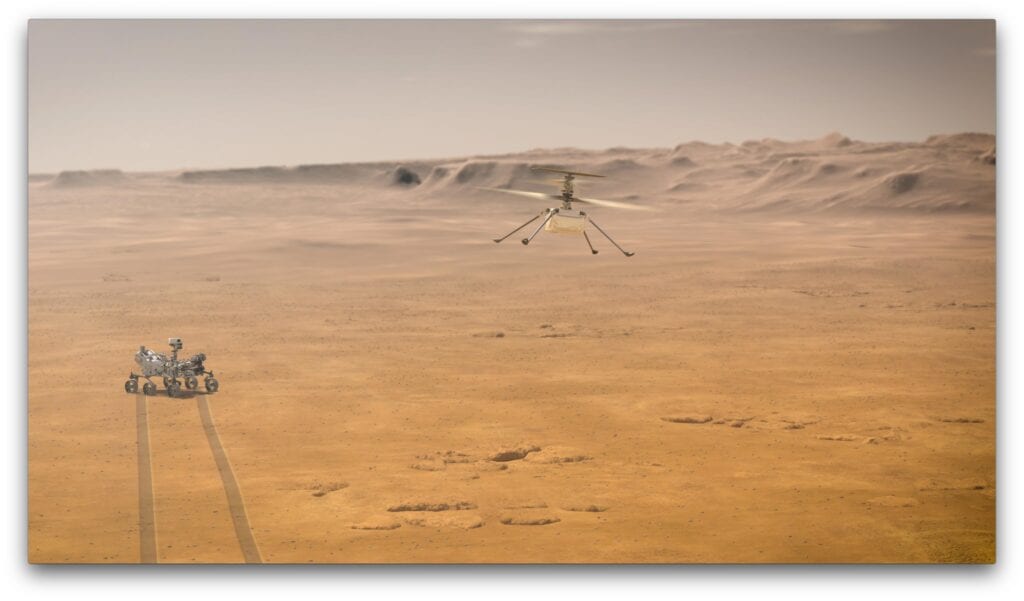
Ingenuity, a technology experiment, will be the first aircraft to attempt controlled flight on another planet. When it attempts its test flights on Mars in spring 2021, Ingenuity will remain within a 0.6-mile (1-kilometer) radius of Perseverance so it can communicate wirelessly with the rover. Perseverance then communicates with relay orbiters around Mars that send the signal back to Earth. (NASA)
On Feb. 18 NASA landed the Perseverance rover on Mars. Inside the belly of Perseverance sits Ingenuity, a four-pound (1.5 pounds on Mars) rotorcraft technology demonstrator that will attempt to fly in the unforgiving Martian atmosphere.
“The Wright Brothers showed that powered flight in Earth’s atmosphere was possible, using an experimental aircraft,” Håvard Grip, Ingenuity’s chief pilot at NASA’s Jet Propulsion Laboratory in Southern California, said in a press statement. “With Ingenuity, we’re trying to do the same for Mars.”
On Feb. 20 NASA’s Jet Propulsion Laboratory received its first status report from Ingenuity from a connection through the Mars Reconnaissance Orbitor, NASA announced. The downlink indicated that the helicopter and base station are operating as expected. Ingenuity will remain attached to Perseverance for 30 to 60 days before deploying.

Perseverance is the most sophisticated rover NASA has ever sent to Mars. Ingenuity, a technology experiment, will be the first aircraft to attempt controlled flight on another planet. (NASA)
“There are two big-ticket items we are looking for in the data: the state of charge of Ingenuity’s batteries as well as confirmation the base station is operating as designed, commanding heaters to turn off and on to keep the helicopter’s electronics within an expected range,” Tim Canham, Ingenuity Mars Helicopter operations lead at JPL, said. “Both appear to be working great. With this positive report, we will move forward with tomorrow’s charge of the helicopter’s batteries.”
So far Ingenuity has completed its first milestone: surviving the launch, cruise, and landing on Mars. Deploying from Perseverance’s belly will be its next challenge. Ingenuity will then have to survive cold Martian nights and autonomously charge itself with its solar panel. All of these obstacles have to be overcome before the aircraft even attempts flight, which it will do autonomously.

In this image, taken on April 29, 2020, the underside of the rover is visible, along with the Ingenuity helicopter attached (lower center of the image). The outer ring is the base of the back shell, while the bell-shaped objects covered in red material are covers for engine nozzles on the descent stage. The wheels are covered in a protective material that will be removed before launch. (NASA)
“We are in uncharted territory, but this team is used to that,” MiMi Aung, project manager for the Ingenuity Mars Helicopter at JPL, said. “Just about every milestone from here through the end of our flight demonstration program will be a first, and each has to succeed for us to go on to the next. We’ll enjoy this good news for the moment, but then we have to get back to work.”
Mars’ atmosphere is 99 percent less dense than Earth’s which means Ingenuity has to be very light and have large fast spinning rotor blades. Ingenuity’s blades have a wingspan of about four feet and are made from carbon fiber foam core.
“Mars is extremely difficult to fly at because atmospheric compared to Earth at Mars is less than 1 percent,” Aung said in a press statement. “So the first and foremost challenge is to make a vehicle this light enough to be lifted. And then, the second is to generate lift the rotor system has to spin very fast. Spinning between 2,000 to 3,000 revolutions per minute, and it takes a lot of energy. So, it’s that balance of a very light system. Yet, having enough energy, this needed to spin the rotor so fast and lift, and on top of it, having to design and the autonomy.”

Members of the NASA Mars Helicopter team inspect the flight model (the actual vehicle going to the Red Planet), inside the Space Simulator, a 25-foot-wide (7.62-meter-wide) vacuum chamber at NASA’s Jet Propulsion Laboratory in Pasadena, California, on Feb. 1, 2019. (NASA)
The first test flight will be done completely autonomously because of the communications delays between Earth and Mars. The initial goal is just to get the aircraft off the ground.
“The main thing is we want to get the legs off the ground,” Grip said. ‘And so we will basically go up about three meters, and we’ll hover there, and then come down again and that will be the first you know really major milestone.”
If the first flight is successful, NASA has additional flight tests planned with increasing levels of difficulty. Ingenuity could end up taking five flights total if everything goes to plan.
“Most of our flights will be at the three to five meter height,” Bob Balaram, Mars Helicopter chief engineer at JPL, said in a press statement.